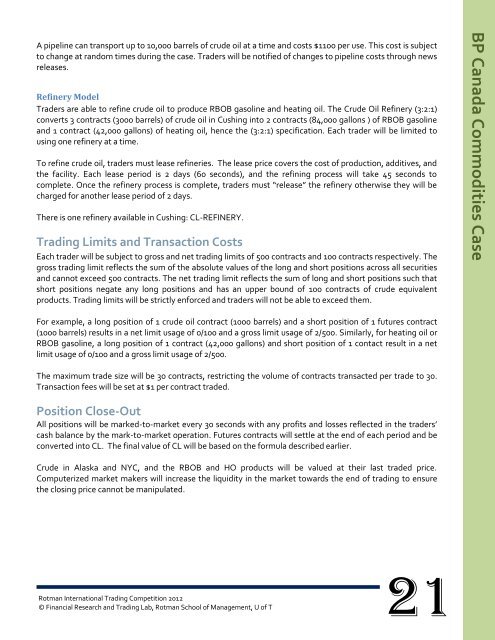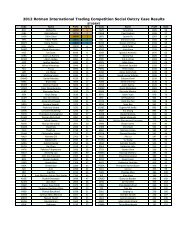RITC 2012 Case Package - Rotman International Trading ...
RITC 2012 Case Package - Rotman International Trading ...
RITC 2012 Case Package - Rotman International Trading ...
You also want an ePaper? Increase the reach of your titles
YUMPU automatically turns print PDFs into web optimized ePapers that Google loves.
A pipeline can transport up to 10,000 barrels of crude oil at a time and costs $1100 per use. This cost is subject<br />
to change at random times during the case. Traders will be notified of changes to pipeline costs through news<br />
releases.<br />
Refinery Model<br />
Traders are able to refine crude oil to produce RBOB gasoline and heating oil. The Crude Oil Refinery (3:2:1)<br />
converts 3 contracts (3000 barrels) of crude oil in Cushing into 2 contracts (84,000 gallons ) of RBOB gasoline<br />
and 1 contract (42,000 gallons) of heating oil, hence the (3:2:1) specification. Each trader will be limited to<br />
using one refinery at a time.<br />
To refine crude oil, traders must lease refineries. The lease price covers the cost of production, additives, and<br />
the facility. Each lease period is 2 days (60 seconds), and the refining process will take 45 seconds to<br />
complete. Once the refinery process is complete, traders must “release” the refinery otherwise they will be<br />
charged for another lease period of 2 days.<br />
There is one refinery available in Cushing: CL-REFINERY.<br />
<strong>Trading</strong> Limits and Transaction Costs<br />
Each trader will be subject to gross and net trading limits of 500 contracts and 100 contracts respectively. The<br />
gross trading limit reflects the sum of the absolute values of the long and short positions across all securities<br />
and cannot exceed 500 contracts. The net trading limit reflects the sum of long and short positions such that<br />
short positions negate any long positions and has an upper bound of 100 contracts of crude equivalent<br />
products. <strong>Trading</strong> limits will be strictly enforced and traders will not be able to exceed them.<br />
For example, a long position of 1 crude oil contract (1000 barrels) and a short position of 1 futures contract<br />
(1000 barrels) results in a net limit usage of 0/100 and a gross limit usage of 2/500. Similarly, for heating oil or<br />
RBOB gasoline, a long position of 1 contract (42,000 gallons) and short position of 1 contact result in a net<br />
limit usage of 0/100 and a gross limit usage of 2/500.<br />
The maximum trade size will be 30 contracts, restricting the volume of contracts transacted per trade to 30.<br />
Transaction fees will be set at $1 per contract traded.<br />
Position Close-Out<br />
All positions will be marked-to-market every 30 seconds with any profits and losses reflected in the traders’<br />
cash balance by the mark-to-market operation. Futures contracts will settle at the end of each period and be<br />
converted into CL. The final value of CL will be based on the formula described earlier.<br />
Crude in Alaska and NYC, and the RBOB and HO products will be valued at their last traded price.<br />
Computerized market makers will increase the liquidity in the market towards the end of trading to ensure<br />
the closing price cannot be manipulated.<br />
<strong>Rotman</strong> <strong>International</strong> <strong>Trading</strong> Competition <strong>2012</strong><br />
© Financial Research and <strong>Trading</strong> Lab, <strong>Rotman</strong> School of Management, U of T<br />
21<br />
BP Canada Commodities <strong>Case</strong>



